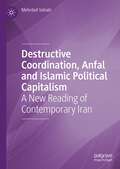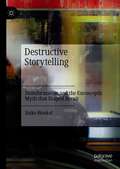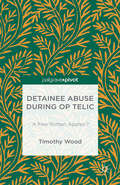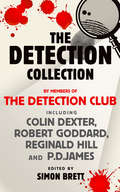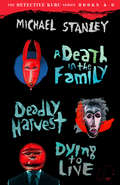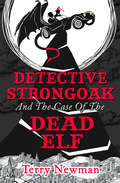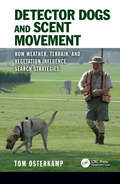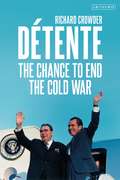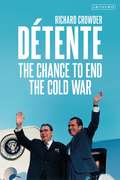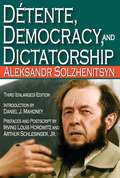- Table View
- List View
Destroying a Nation: The Civil War in Syria
by Nikolaos Van DamFollowing the Arab Spring, Syria descended into civil and sectarian conflict. It has since become a fractured warzone which operates as a breeding ground for new terrorist movements including ISIS as well as the root cause of the greatest refugee crisis in modern history. In this book, former Special Envoy of the Netherlands to Syria Nikolaos van Dam explains the recent history of Syria, covering the growing disenchantment with the Assad regime, the chaos of civil war and the fractures which led to the rise and expansion of ISIS. Through an in-depth examination of the role of sectarian, regional and tribal loyalties in Syria, van Dam traces political developments within the Assad regime and the military and civilian power elite from the Arab Spring to the present day.
The Destruction of Cultural Property as a Weapon of War: ISIS in Syria and Iraq
by Helga TurkuThis book aims to advance the understanding of cultural property in armed conflict, and its significance for anti-terrorism and peace-building strategies. As the author argues, ISIS’ orchestrated theft and destruction of cultural property has become a tactic of war. Through a historical, political, and legal analysis, this book explains the pathology of radical groups’ behavior toward cultural objects as part of their terror campaign. Using constructivist ideas, it explains the importance of cultural property in the context of short-term and long-term security and analyzes the evolution of laws and policies to protect it.
The Destruction of the Soviet Economic System: An Insider's History
by Michael Ellman Vladimir KontorovichThe inside story of the political collpase of the Soviet Union is far better understood than the course of economic and social disintegration. In order to capture the story, the editors compiled a list of questions which they addressed to former top Soviet officials and economic and other policy advisors (both Soviet and foreign) who were privy not only to data on the functioning of the Soviet economy but also to the internal policy debate during the 1980s. This volume assembles the Informants' analyses of key issues and the turning points, and weaves them into a compelling history of systemic collapse. Among the topics investigated are: economic policies in the 1980s; the standard of living: the reliability of Soviet statistics; Gosplan's projections for the economy to the year 2000; was the arms race starving the civilian economy? the role of ideology in supporting the functioning of an economic system; the party's participating in economic management; the influence of foreign advisors; the struggle over a transition program; the functioning and collapse of the supply system, the CMEA, and the foreign trade system.
The Destruction of the Soviet Economic System: An Insider's History
by Michael Ellman Vladimir KontorovichThe inside story of the political collpase of the Soviet Union is far better understood than the course of economic and social disintegration. In order to capture the story, the editors compiled a list of questions which they addressed to former top Soviet officials and economic and other policy advisors (both Soviet and foreign) who were privy not only to data on the functioning of the Soviet economy but also to the internal policy debate during the 1980s. This volume assembles the Informants' analyses of key issues and the turning points, and weaves them into a compelling history of systemic collapse. Among the topics investigated are: economic policies in the 1980s; the standard of living: the reliability of Soviet statistics; Gosplan's projections for the economy to the year 2000; was the arms race starving the civilian economy? the role of ideology in supporting the functioning of an economic system; the party's participating in economic management; the influence of foreign advisors; the struggle over a transition program; the functioning and collapse of the supply system, the CMEA, and the foreign trade system.
The Destruction of the Soviet Union: A Study in Globalization
by D. LockwoodIs there a link between the collapse of the Soviet Union, the radical reforms in China and Vietnam, and the current crisis in East Asia? David Lockwood argues that the common factor in each is the crisis of state-controlled economies, besieged by the developing forces of globalization. This book examines the collapse of the Soviet Union not as the 'end of history', or the beginning of a 'new world order', but as an illustration of processes that are taking place the world over. The author concludes that it was globalization that brought down the communist system. Globalization continues to threaten state-controlled economies - from the remaining 'socialist' state to the NICs of East Asia.
Destructive Coordination, Anfal and Islamic Political Capitalism: A New Reading of Contemporary Iran
by Mehrdad VahabiThis book introduces a new theoretical framework that examines Iran in relation to the theological concept of Anfal, a confiscatory regime seen in Iran since 1979 where public assets belong to the leader of Iran. Through analysing the economic impacts of Anfal, the effects of political capitalism and destructive coordination and how they lead to the economics of hoarding and the flight of capital and labour are highlighted. The economics of predation, ecological disaster, and cooperative coordination are also discussed. This book aims to highlight the economic consequences of Anfal and its role in sustaining destructive condition and shaping the Islamic political capitalism. It will be relevant to students and researchers interested in the political economy, Middle Eastern and Islamic studies.
Destructive Storytelling: Disinformation and the Eurosceptic Myth that Shaped Brexit
by Imke HenkelThis book offers a new approach to understanding disinformation and its destructive impact on the democratic function of the news media. Using the notoriously false reporting of EU policies by the British press as a starting point, it utilises Critical Discourse Analysis to examine the linguistic properties of false news stories and to understand how they function as myth in Roland Barthes’ sense. The disinformation is essential for the impact these news stories had as it provides the simplification which creates the blissful clarity of myth that Barthes described. As myth, the false news stories depoliticised a political argument and naturalised the claim of antagonistic British-European relations. Henkel shows how news stories used disinformation to articulate a Eurosceptic myth of the feisty, witty Briton who stands up against the European bully. Her main argument is that the disinformation contributed to the Brexit vote because, as myth, it transported an ideology. Henkel argues that the Brexit debate and the news reporting that preceded it for decades can be understood as a case study for how political journalism becomes democratically dysfunctional. This book will be of interest to students and scholars of journalism, media and culture, political communication, and Critical Discourse Analysis.
Detained without Cause: Muslims' Stories of Detention and Deportation in America after 9/11 (Palgrave Studies in Oral History)
by I. ShiekhImmigrants from Pakistan, Egypt, India, and Palestine who were racially profiled and detained following the September 11 attacks tell their personal stories in a collection which explores themes of transnationalism, racialization, and the global war on terror, and explains the human cost of suspending civil liberties after a wartime emergency.
Detainee Abuse During Op TELIC: ‘A Few Rotten Apples’?
by Timothy WoodThis book reviews the nature of the alleged abuse committed by the UK military forces, exploring the legal paradigm in which the abuse allegedly occurred; the morality of those accused; and the robustness of the accusation of a 'policy of abuse'.
Detect and Deter: Can Countries Verify the Nuclear Test Ban?
by Ola Dahlman Jenifer Mackby Svein Mykkeltveit Hein HaakHow can countries verify compliance with the Comprehensive Nuclear-Test-Ban Treaty (CTBT) and detect and deter violations? It is in their interest to increase their verification readiness because the assessment of compliance with the treaty rests with states parties to the CTBT. The treaty provides countries with two verification elements: an international system of monitoring stations, and an on-site inspection regime. The monitoring system can detect nuclear explosions underground, in the atmosphere and under water. This book provides incentives to nations around the world on how they can organize their efforts to verify compliance with the CTBT and how they can collaborate with other countries, perhaps on a regional basis, to monitor areas of concern. Such focused efforts can improve their detection and deterrence capabilities through precision monitoring. The book addresses the CTBT verification from the perspective of countries. It shows how they can create the essential tools for the assessment of the large amounts of data available from the verification regime and other sources, including observations from satellites and thousands of stations outside of the treaty regime. Countries can also use current scientific and technological developments to assist them in verifying compliance with the treaty. The book offers political and scientific analysis on the evolution of the treaty over the years. The book is intended for professionals in the political, diplomatic, scientific and military fields who deal with international security, non-proliferation and arms control. It is also intended for non-governmental organizations and journalists seeking a better understanding of the nuclear test ban issue and how states can verify compliance with the treaty.
Detecting Danger: Detecting Danger Proof Of Innocence (Capitol K-9 Unit #5)
by Valerie HansenEXPLOSIVE SECRETS
The Detection Collection
by The Detection Club Colin Dexter Robert Goddard Reginald Hill P.D. JamesTen years since it was first published in hardback, and now for the first time as an eBook, this volume of short stories by the cream of British crime writing talent celebrates 75 years of the quintessential Detection Club.
Detective Kubu collection
by Michael StanleyBooks 4,5 and 6 of THE DETECTIVE KUBU COLLECTIONAssistant Superintendent David ‘Kubu’ Bengu of the Botswana Criminal Investigation Department returns to solve a series of dark, devastating crimes that run deep into the heart of the community and far, far beyond … Sunshine Noir at its very finest…BOOK ONE – Deadly HarvestFinalist for the Best Paperback Original Novel at the International Thriller Writers AwardA young girl goes missing after getting into a car with a mysterious man. Soon after, a second girl disappears, and her devastated father, Witness, sets out to seek revenge.As the trail goes cold, Samantha Khama – new recruit to the Botswana Criminal Investigation Department – suspects the girl was killed for muti, the traditional African medicine usually derived from plants, sometimes animals, and, recently and most chillingly, human parts. When the investigation gets personal, Samantha enlists opera-loving wine connoisseur Assistant Superintendent David ‘Kubu’ Bengu to help her dig into the past.As they begin to discover a pattern to the disappearances, there is another victim, and Kubu and Samantha are thrust into a harrowing race to stop a serial killer who has only one thing in mind…BOOK TWO – A Death in the Family‘There’s no easy way to say this, Kubu. Your father’s dead. I’m afraid he’s been murdered.’Faced with the violent death of his own father, even Assistant Superintendent David ‘Kubu’ Bengu, Botswana CID’s keenest mind, is baffled. Who would kill such a frail old man? The picture becomes even murkier with the apparent suicide of a government official. Are Chinese mine-owners involved? And what role does the US Embassy have to play?Set amidst the dark beauty of modern Botswana, A Death in the Family is a thrilling insight into a world of riots, corruption and greed, as a complex series of murders present the opera-loving, wine connoisseur detective with his most challenging case yet.When grief-stricken Kubu defies orders and sets out on the killers’ trail, startling and chilling links emerge, spanning the globe and setting a sequence of shocking events in motion.Will Kubu catch the killers in time … and find justice for his father?BOOK THREE – Dying To LiveWhen the body of a Bushman is discovered near the Central Kalahari Game Reserve, the death is written off as an accident. But all is not as it seems. An autopsy reveals that, although he’s clearly very old, his internal organs are puzzlingly young. What’s more, an old bullet is lodged in one of his muscles … but where is the entry wound?When the body is stolen from the morgue and a local witch doctor is reported missing, Detective ‘Kubu’ Bengu gets involved. Kubu and his brilliant young colleague, Detective Samantha Khama, follow the twisting trail through a confusion of rhino-horn smugglers, foreign gangsters and drugs manufacturers. And the deeper they dig, the wider and more dangerous the case becomes…A fresh, new slice of ‘Sunshine Noir’, Dying to Live is a classic tale of greed, corruption and ruthless thuggery, set in one of the world’s most beautiful landscapes, and featuring one of crime fiction’s most endearing and humane heroes.A wonderful, original voice – McCall Smith with a dark edge and even darker underbelly’ Peter James‘My favourite writing duo since Ellery Queen’ Ragnar Jónasson‘It kept me guessing, and it kept me gasping at its many twists and surprises’ R.L. Kline‘Richly atmospheric … a gritty depiction of corruption and deception’ Publishers Weekly‘Compelling and deceptively written …’ New York Journal of Books
Detective Strongoak and the Case of the Dead Elf
by Terry NewmanCSI in the land of elves, but they aren’t cute and christmassy, they’re sometimes sinister, and definitely deceased…
Detector Dogs and Scent Movement: How Weather, Terrain, and Vegetation Influence Search Strategies
by Tom OsterkampDogs detect scent from a source that is carried to them in a plume by the wind. The most important tool for a detector dog handler to have on searches is a knowledge of scent plume movement or "scent dynamics" (the science of scent movement). Such knowledge resides primarily in scientific journals that are largely inaccessible to detector dog handlers and written in language that is difficult to understand. Detector Dogs and the Science of Scent Movement: A Handler’s Guide to Environments and Procedures retrieves, reviews, and interprets the results of pertinent scientific research on scent dynamics and presents these results in terms that are easier for handlers to understand. Information on the physiology of the dog’s nose, their sense of smell, and the properties of scent provide the essential information on the process of scenting. The composition of training aids for explosives, narcotics, human remains and other sources is discussed. Recommendations are made on the use of training aids, their placement during training, and the resulting availability of scent. Potential problems and handler errors in the use of training aids are also examined. The characteristics of scent plumes and how wind influences their movement are a key focus of the book. The primary task for the handler is to get the dog into the scent plume so that the dog can detect the scent and follow it to the source the handler seeks. As such, a knowledge of scent and scent plume movement will vastly improve the ability of the handler to accomplish this task. The influence of weather and physical settings such as terrain, vegetation, ground cover, soil and water on scent movement are examined in detail. Strategies for searching, detecting, and locating sources in all physical settings are presented. Specific effects associated with hills and mountains, fields and forests, bare soils and soils covered by vegetation, different soil types, and lakes and rivers are examined in detail. This includes specific recommendations are made about weather and physical settings that result in higher probability of success on searches. Detector Dogs and the Science of Scent Movement will be a vital resource for K9 handles in the private and public sectors—including in Homeland Security, law enforcement, and military settings—as well as a useful guide for lawyers, forensic, and investigative professionals who need to better understand K9 operations.
Detector Dogs and Scent Movement: How Weather, Terrain, and Vegetation Influence Search Strategies
by Tom OsterkampDogs detect scent from a source that is carried to them in a plume by the wind. The most important tool for a detector dog handler to have on searches is a knowledge of scent plume movement or "scent dynamics" (the science of scent movement). Such knowledge resides primarily in scientific journals that are largely inaccessible to detector dog handlers and written in language that is difficult to understand. Detector Dogs and the Science of Scent Movement: A Handler’s Guide to Environments and Procedures retrieves, reviews, and interprets the results of pertinent scientific research on scent dynamics and presents these results in terms that are easier for handlers to understand. Information on the physiology of the dog’s nose, their sense of smell, and the properties of scent provide the essential information on the process of scenting. The composition of training aids for explosives, narcotics, human remains and other sources is discussed. Recommendations are made on the use of training aids, their placement during training, and the resulting availability of scent. Potential problems and handler errors in the use of training aids are also examined. The characteristics of scent plumes and how wind influences their movement are a key focus of the book. The primary task for the handler is to get the dog into the scent plume so that the dog can detect the scent and follow it to the source the handler seeks. As such, a knowledge of scent and scent plume movement will vastly improve the ability of the handler to accomplish this task. The influence of weather and physical settings such as terrain, vegetation, ground cover, soil and water on scent movement are examined in detail. Strategies for searching, detecting, and locating sources in all physical settings are presented. Specific effects associated with hills and mountains, fields and forests, bare soils and soils covered by vegetation, different soil types, and lakes and rivers are examined in detail. This includes specific recommendations are made about weather and physical settings that result in higher probability of success on searches. Detector Dogs and the Science of Scent Movement will be a vital resource for K9 handles in the private and public sectors—including in Homeland Security, law enforcement, and military settings—as well as a useful guide for lawyers, forensic, and investigative professionals who need to better understand K9 operations.
Détente: The Chance to End the Cold War
by Richard CrowderBetween 1968 and 1975, there was a subtle thawing of relations between East and West, for which Brezhnev coined the name Détente, and – perhaps – a chance to end the Cold War. The leaders of the United States and the Soviet Union, Richard Nixon and Leonid Brezhnev, hoped to forge a new relationship between East and West. Yet, the greatest changes of the era took place outside the sphere of international diplomacy. The 1960s brought social collision across the world, from the anti-war protests in America to the student demonstrations on the streets of Paris, and Mao Tsetung's Red Guards in China. A new generation, whom advertising executives dubbed the baby-boomers, brought new attitudes to towards sex, gender, race, the environment and religion. In this book, Richard Crowder explores the years of Détente, and introduces us to the key players of the era, whose stories form the narrative of this book.
Détente: The Chance to End the Cold War
by Richard CrowderBetween 1968 and 1975, there was a subtle thawing of relations between East and West, for which Brezhnev coined the name Détente, and – perhaps – a chance to end the Cold War. The leaders of the United States and the Soviet Union, Richard Nixon and Leonid Brezhnev, hoped to forge a new relationship between East and West. Yet, the greatest changes of the era took place outside the sphere of international diplomacy. The 1960s brought social collision across the world, from the anti-war protests in America to the student demonstrations on the streets of Paris, and Mao Tsetung's Red Guards in China. A new generation, whom advertising executives dubbed the baby-boomers, brought new attitudes to towards sex, gender, race, the environment and religion. In this book, Richard Crowder explores the years of Détente, and introduces us to the key players of the era, whose stories form the narrative of this book.
Detente, Democracy and Dictatorship
by Aleksandr SolzhenitsynThe subject of Detente, Democracy and Dictatorship has been with us since the breakdown of the Cold War and the termination of the Soviet system, indeed, if not since the origins of Bolshevism. No more vigorous critic of the uneasy co-existence of democracy and dictatorship exists than the greatest writer that the Soviet era of Russian history produced, Aleksandr Solzhenitsyn.This third edition is based on major addresses, especially aimed at Americans, delivered in 1975 in Washington, D.C. and New York, and again, in 1978, at Harvard University in Cambridge, all on the subject of detente, democracy and dictatorship. It also includes Solzhenitsyn's final 2007 interview with the German publication Der Spiegel.These major statements are brilliant and forthright comment on the risks of confusing ideology with diplomacy. But more than that, they summarize the Soviet debacle, the theoretical underpinnings, and distill Solzhenitsyn's multi-volumed masterpiece, the Gulag Archipelago.
Detente, Democracy and Dictatorship
by Aleksandr SolzhenitsynThe subject of Detente, Democracy and Dictatorship has been with us since the breakdown of the Cold War and the termination of the Soviet system, indeed, if not since the origins of Bolshevism. No more vigorous critic of the uneasy co-existence of democracy and dictatorship exists than the greatest writer that the Soviet era of Russian history produced, Aleksandr Solzhenitsyn.This third edition is based on major addresses, especially aimed at Americans, delivered in 1975 in Washington, D.C. and New York, and again, in 1978, at Harvard University in Cambridge, all on the subject of detente, democracy and dictatorship. It also includes Solzhenitsyn's final 2007 interview with the German publication Der Spiegel.These major statements are brilliant and forthright comment on the risks of confusing ideology with diplomacy. But more than that, they summarize the Soviet debacle, the theoretical underpinnings, and distill Solzhenitsyn's multi-volumed masterpiece, the Gulag Archipelago.
Détente in Asia? (St Antony's Series)
by Leslie H. PalmierIn this text, 12 authors discuss the extent to which detente between the superpowers has been reflected in Asia. The roles of the United States, the Soviet Union and China are considered, together with the situation prevailing in those countries which have been the object of superpower rivalry.
Detention under the Immigration Acts: Law and Practice
by Rory Dunlop Graham DenholmThe UK has some of the largest immigration detention facilities in Europe, holding as many as 3000 individuals at any point in time. Foreign nationals are held under immigration powers in a variety of circumstances including on arrival pending examination, whilst an asylum claim is considered in the Detained Fast Track, and pending administrative removal or deportation. The routine use of detention powers, particularly in relation to foreign national offenders, has increased dramatically in the years since 2006. Advising individuals detained under immigration powers is no longer a niche field. An increasing number of practitioners need access to a clear reference guide when faced with cases which touch on this issue. Detention under the Immigration Acts: Law and Practice is the only text to provide a comprehensive and detailed account of the statutory powers underpinning immigration detention and the limitations on those powers afforded by the common law, the European Convention on Human Rights, and the law of the European Union. It is an invaluable resource not only for those working predominantly in immigration but also practitioners whose work may touch on this increasingly complex area, whether from a civil or criminal perspective, as well as the judiciary and government officials with a need for clear legal guidance. Taking a practice-focused approach, the work addresses the procedural aspects of litigation challenging detention, from bail applications in the Tribunal through judicial review claims in the Administrative Court, to civil claims before the County Court and the Queen's Bench Division of the High Court. It offers unparalleled coverage of the many hundreds of domestic cases on the subject, saving practitioners valuable time in their legal research. It also examines, in more detail than has ever been done before, the case law of the European Court of Human Rights and the Court of Justice of the European Union and suggests arguments to challenge detention and seek damages that have not so far been used in domestic courts. Written by an author team representing both claimant and government interests, key issues are considered from a neutral perspective, providing a balanced and detailed exploration of the common law and policy based principles governing the exercise of immigration detention powers.
Detention under the Immigration Acts: Law and Practice
by Rory Dunlop Graham DenholmThe UK has some of the largest immigration detention facilities in Europe, holding as many as 3000 individuals at any point in time. Foreign nationals are held under immigration powers in a variety of circumstances including on arrival pending examination, whilst an asylum claim is considered in the Detained Fast Track, and pending administrative removal or deportation. The routine use of detention powers, particularly in relation to foreign national offenders, has increased dramatically in the years since 2006. Advising individuals detained under immigration powers is no longer a niche field. An increasing number of practitioners need access to a clear reference guide when faced with cases which touch on this issue. Detention under the Immigration Acts: Law and Practice is the only text to provide a comprehensive and detailed account of the statutory powers underpinning immigration detention and the limitations on those powers afforded by the common law, the European Convention on Human Rights, and the law of the European Union. It is an invaluable resource not only for those working predominantly in immigration but also practitioners whose work may touch on this increasingly complex area, whether from a civil or criminal perspective, as well as the judiciary and government officials with a need for clear legal guidance. Taking a practice-focused approach, the work addresses the procedural aspects of litigation challenging detention, from bail applications in the Tribunal through judicial review claims in the Administrative Court, to civil claims before the County Court and the Queen's Bench Division of the High Court. It offers unparalleled coverage of the many hundreds of domestic cases on the subject, saving practitioners valuable time in their legal research. It also examines, in more detail than has ever been done before, the case law of the European Court of Human Rights and the Court of Justice of the European Union and suggests arguments to challenge detention and seek damages that have not so far been used in domestic courts. Written by an author team representing both claimant and government interests, key issues are considered from a neutral perspective, providing a balanced and detailed exploration of the common law and policy based principles governing the exercise of immigration detention powers.
Determinanten der Auslandsberichterstattung: Eine Mehrebenenanalyse des internationalen Nachrichtenflusses
by Christine HeimprechtChristine Heimprecht zeigt anhand einer Weiterentwicklung theoretischer Konzepte der Nachrichtenwerttheorie sowie einer Mehrebenenanalyse des internationalen Nachrichtenflusses aus 16 Ländern, wie Journalisten in den verschiedensten Regionen der Welt Auslandsnachrichten gestalten, woran sie sich bei der Darstellung des Auslands orientieren und welche Einflüsse der Gesellschaft die Arbeit der Journalisten prägen. Hierbei wird zum einen die enorme Bedeutung internationaler Wirtschaftsbeziehungen deutlich. Zum anderen wird die Relevanz der Pressefreiheit und des neu eingeführten Nachrichtenfaktors Krisenstatus bestätigt. Insgesamt wird ein neuer Blick auf die internationale Kriegs- und Krisenberichterstattung geworfen und die engen Verbindungen zwischen Politik, Militär und den Medien beleuchtet, welche weltweit die Arbeit der Journalisten beeinflussen.
Determinanten der Demokratiezufriedenheit: Einfluss ökonomischer Faktoren auf die politische Kultur in der BRD (Politische Kultur in den neuen Demokratien Europas)
by Hendrik LangeHendrik Lange untersucht basierend auf Theorien relativer Deprivation, allgemeiner Lebenszufriedenheit und sozialen Kapitals, den Zusammenhang zwischen Gehaltsniveau und Demokratiefeindlichkeit. Er kann zeigen, dass demokratiefeindliche Handlungen erst ab einem sehr hohen Maß an Unzufriedenheit zu erwarten sind. Allerdings wirken sich bereits kleinste Verschlechterungen des objektiven soziökonomischen Status deutlich auf die subjektive Beurteilung des eigenen Status aus. Derartige Befunde verdeutlichen, warum auch in gefestigten Demokratien demokratiefeindliche Bewegungen sehr plötzlich große Erfolge vorweisen können. Die empirischen Analysen basieren auf Daten des European Social Survey (ESS), des World Values Survey (WVS) und der German Longitudinal Election Study (GLES). e="font-si




